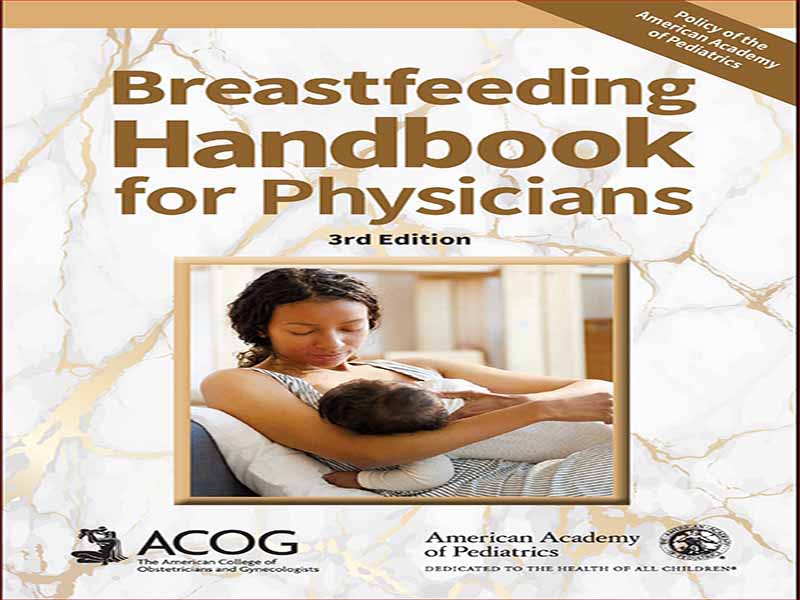- عنوان: Breastfeeding Handbook for Physicians
- نویسنده: American Academy of Pediatrics
- حوزه: پزشکی اطفال
- سال انتشار: 2023
- تعداد صفحه: 453
- زبان اصلی: انگلیسی
- نوع فایل: pdf
- حجم فایل: 11.0 مگابایت
مانند نسخه های قبلی، این ویرایش سوم کتابچه راهنمای تغذیه با شیر مادر برای پزشکان نوشته شده است تا به پزشکان در همه تخصص ها یک آموزش مختصر و ارزان و کمک مرجع در مورد شیردهی و شیردهی انسان ارائه دهد. هدف کلی کتاب راهنما افزایش دانش پزشکان در مورد فیزیولوژی شیردهی و عملکرد بالینی است به طوری که آنها در ترویج و حمایت از شیردهی راحت باشند. کتابچه راهنمای تغذیه با شیر مادر برای پزشکان می تواند به عنوان راهنمایی برای آموزش تئوری و عمل تغذیه با شیر مادر و شیردهی به دانشجویان، دستیاران و دانشجویان پزشکی مورد استفاده قرار گیرد. به طور مشابه، برنامه های تحصیلات تکمیلی پزشکی مداوم را می توان بر اساس محتوای آن ایجاد کرد. امید است این کتاب راهنمای پزشکان را تشویق کند تا معلمان تغذیه با شیر مادر و شیردهی شوند. از آنجایی که این کتابچه به طور مشترک نوشته شده است تا نشان دهنده تلاش های مشترک آکادمی اطفال آمریکا و کالج آمریکایی متخصصان زنان و زایمان باشد، به همکاری بین پزشکان و بین پزشکان و سایر متخصصان مراقبت های بهداشتی – به ویژه متخصصان شیردهی می پردازد. برای تشخیص پزشک به عنوان هماهنگ کننده یک تیم مراقبت های بهداشتی که متشکل از تعداد زیادی متخصص دیگر است، مفهوم خانه پزشکی برای نوزاد و مادر در کتاب تاکید شده است تا به ارائه چارچوبی برای ایجاد بیمارستان و مطب کمک کند. سیاست ها در حالی که این کتاب عمدتاً برای پزشکان طراحی شده است، استفاده توسط سایر متخصصان مراقبت های بهداشتی، از جمله پرستاران، متخصصان تغذیه، و متخصصان شیردهی مورد استقبال قرار می گیرد. استفاده از آن می تواند به عنوان پلی بین این متخصصان مراقبت های بهداشتی و پزشکان در دستیابی به مراقبت هماهنگ و بهینه باشد. این نسخه از کتاب راهنما حاوی بهروزرسانیهایی در مورد شواهد مهم شیردهی و همچنین اقدامات بالینی است. فصل اول به شواهدی که در پس منطق شیردهی و اپیدمیولوژی تغذیه با شیر مادر در ایالات متحده وجود دارد، می پردازد. دادههای کاهش ریسک برای ارائه تخمینی از اثرات به خوانندگان ارائه شده است. بخش ترکیب شیر با یک فصل جداگانه در مورد اجزای غیر مغذی در شیر انسان تقویت شده است تا اطلاعات بیشتری را در مورد چگونگی توضیح عوامل فعال زیستی و میکروبیوم در اختیار پزشکان قرار دهد تا برخی از اثرات محافظتی شیردهی را توضیح دهند. فصلهایی که در ادامه میآیند در قالب چرخه حیات سازماندهی شدهاند تا امکان ارجاع سریع را فراهم کنند. این فصلها شامل بخشهای گستردهای در مورد مسائل معاصر در مدیریت تغذیه با شیر مادر است، مانند ده قدم برای موفقیت در شیردهی، تماس پوست به پوست و خواب ایمن، ارزیابی تغییرات وزن نوزاد و نوزاد، داروها، سازمان بهداشت جهانی/ صندوق کودکان ملل متحد که اخیراً تجدیدنظر شده است. و استفاده از واکسن در دوران شیردهی و برنامه ریزی برای بازگشت به کار و شیردهی در محل کار. آگاهی از تغذیه با شیر مادر در ایالات متحده در حال افزایش است. دادههای کنونی نشان میدهد که 83.9 درصد از زنان شیردهی را در بیمارستان آغاز میکنند که به تازگی از اهداف ملی تعیینشده برای سال 2020 فراتر رفته است. نسبت زنانی که نوزادان خود را در یک مرکز مناسب شیردهی به دنیا میآورند بیش از سه برابر اهداف تعیینشده است و تقریباً نیمی از همه زنان در محل کار خود برنامه شیردهی دارند. دادههای مراکز کنترل و پیشگیری از بیماریهای ایالات متحده (کارت گزارش تغذیه با شیر مادر، بررسیهای ملی ایمنسازی، و دادههای بررسی شیوههای تغذیه و مراقبت از نوزادان) در هدایت رویکردهای بالینی در مورد تغذیه با شیر مادر بسیار مفید هستند و بر نیاز به ادامه کار برای از بین بردن نابرابریها در شیردهی تاکید میکنند. نرخ در میان زنان داده های ارائه شده در کتاب راهنما بر اهمیت تغذیه با شیر مادر به عنوان یک ضرورت بهداشت عمومی تاکید می کند و پزشکان باید از تلاش ها برای حذف موانع موفقیت آن حمایت کنند. توصیههای مربوط به تغذیه انحصاری با شیر مادر برای حدود 6 ماه، به دنبال آن افزودن غذاهای کمکی و ادامه شیردهی به مدت 2 سال یا بیشتر به صورت دلخواه مادر و کودک، باید با پایگاه دانشی که در این فصلها یافت میشود، حمایت شود. تدوین کتابچه راهنمای تغذیه با شیر مادر برای پزشکان محصول متخصصان متعدد در زمینه شیردهی و شیردهی انسان است. امیدواریم این مرجع برای آموزش شیردهی مفید واقع شود.
As with prior editions, this third edition of the Breastfeeding Handbook for Physicians is written to provide physicians in all specialties with a concise and inexpensive teaching and reference aid on breastfeeding and human lactation. The overall goal of the handbook is to enhance physicians’ knowledge of lactation physiology and clinical practice so that they become comfortable promoting and supporting breastfeeding. The Breastfeeding Handbook for Physicians can be used as a guide to teach breastfeeding and lactation theory and practice to medical students, residents, and fellows. Similarly, postgraduate continuing medical education programs can be built around its contents. It is hoped that this handbook will encourage physicians to become teachers of breastfeeding and lactation medicine. Because this handbook is written jointly, to represent the collaborative efforts of the American Academy of Pediatrics and the American College of Obstetricians and Gynecologists, it addresses collaboration among physicians and between physicians and other health care professionals—especially lactation specialists. To recognize the physician as the coordinator of a health care team that consists of a large number of other professionals, the concept of a medical home for baby and mother is stressed in the book, to help provide a framework on which to build hospital and office policies. While the book is designed primarily for physicians, use by other health care professionals, including nurses, dietitians, and lactation specialists, is welcomed; its use may serve as a bridge between these health care professionals and physicians in achieving coordinated and optimal care. This edition of the handbook contains updates on important evidence for breastfeeding, as well as clinical practices. The first chapters deal with the evidence behind the rationale for breastfeeding and the epidemiology of breastfeeding in the United States. Risk reduction data are provided to give readers estimates of effects. The section on milk composition has been enhanced with a separate chapter on nonnutritive components in human milk, to provide physicians with additional information on how bioactive factors and the microbiome may explain some of the protective effects of breastfeeding. The chapters that follow are organized in a life-cycle format to allow for quick reference. These chapters contain expanded sections on contemporary issues in breastfeeding management, such as the recently revised World Health Organization/United Nations Children’s Fund Ten Steps to Successful Breastfeeding, skin-to-skin contact and safe sleep, assessment of newborn and infant weight changes, medications and vaccine use during lactation, and plans for return to work and workplace lactation. Breastfeeding awareness is increasing in the United States. Current data indicate that 83.9% of women initiate breastfeeding in the hospital, which just surpassed national targets set for 2020. The proportion of women delivering their newborns in a breastfeeding-friendly facility has more than tripled over set targets, and nearly one-half of all women have a lactation program at their workplace. The US Centers for Disease Control and Prevention data (Breastfeeding Report Card, National Immunization Surveys, and Maternity Practices in Infant Nutrition and Care Survey data) remain extremely useful in guiding clinical approaches to breastfeeding and emphasize the need to continue working toward eliminating disparities in breastfeeding rates among women. The data provided in the handbook underscore the importance of breastfeeding as a public health imperative, and clinicians should support attempts to remove barriers to its success. The recommendations for exclusive breastfeeding for about 6 months, followed by the addition of complementary foods and continued breastfeeding for 2 years or beyond as mutually desired by mother and child, should be advocated with a knowledge base that can be found in these chapters. The development of the Breastfeeding Handbook for Physicians is the product of numerous experts in the field of breastfeeding and human lactation. We hope you will find the reference useful for breastfeeding education.
این کتاب را میتوانید بصورت رایگان از لینک زیر دانلود نمایید.
Download: Breastfeeding Handbook for Physicians




































نظرات کاربران